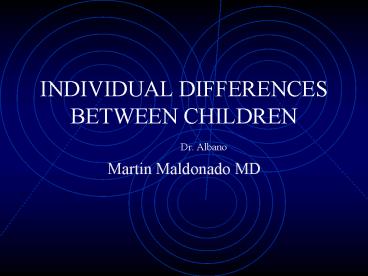INDIVIDUAL DIFFERENCES BETWEEN CHILDREN Dr' Albano - PowerPoint PPT Presentation
1 / 18
Title:
INDIVIDUAL DIFFERENCES BETWEEN CHILDREN Dr' Albano
Description:
Why children who are raised in the 'same' family turn out so different? ... Youngest child might be more dependent and 'whining'? Middle child, 'sandwich', etc. ... – PowerPoint PPT presentation
Number of Views:273
Avg rating:3.0/5.0
Title: INDIVIDUAL DIFFERENCES BETWEEN CHILDREN Dr' Albano
1
INDIVIDUAL DIFFERENCES BETWEEN CHILDREN
Dr. Albano
- Martin Maldonado MD
2
INDIVIDUAL DIFFERENCES BETWEEN CHILDREN
- Why children who are raised in the same family
turn out so different? - What factors shape the personality, preferences,
aptitudes, inclinations of the child? - How do innate traits interact with
interpersonal and environmental factors?
3
Birth Order?
- Older child might be more controlling, orderly
and in need of having things organized? - Youngest child might be more dependent and
whining? - Middle child, sandwich, etc.
- No empirical evidence for this, but it may be a
factor
4
Factors influencing childs development and
character
- I INNATE PREDISPOSITIONS
- GENETIC FACTORS, INHERITANCE
- Evidence of genetic influence for intelligence,
personality traits, and a number of disturbances. - Eg anxiety disorders, dissocial behavior,
- Problems in relating and communicating, learning
difficulties, attention deficit, etc.
5
Factors influencing
- I. INNATE. TEMPERAMENT
- Evidence of clustering according to
- Interest in novelty, new stimuli
- Approach to new things, vs. cautiousness
- Rhythmicity in physiology
- Intensity of responses
- Reactions to frustration, etc.
- Temperament is not so stable
6
Factors influencing
- The physiology and functioning of the child
EG. SENSORY INTEGRATION FUNCTIONING - How does the child react to stimuli? (external
and internal) - How does the child process in the CNS?
- How does the child organize a response?
7
Factors influencing.
- Modularity of the mind
- Modules function with some autonomy re
mathematical ability, language processing, visual
processing, management of auditory input, musical
ability, etc. - Multiple intelligences
8
Talents and challenges
- Eg. Graphic representation, artistic talent,
different from language processing and
organizational skills. - Discrepancies in functioning, e.g. auditory
learning vs visual learning - hands on child vs. an intellectual, etc.
9
Resilience in the child
- Attitude, sense of humor, attractiveness
- Openness toward other people
- Ability to engage other people
- Cognitive style, intelligence
- Ability to elicit help and to be involved with
others - Reaction to adverse experiences.
10
Factors influencing development
- II. EXPERIENTIAL FACTORS. EG.
- CHILD REARING STYLE
- . What characteristics are desirable in a
child? - What do we want for our children?
- What characteristics are fostered and
discouraged?
11
Child rearing styles
- Largely influenced by cultural themes
- Largely influenced by individual experiences as a
child - Child rearing techniques are not scientific
- They are based on preferences and values, e.g.
independence, autonomy, assertiveness, sleeping
arrangements, discipline, etc.
12
Transgenerational myths and factors
- Fantasmatic interactions
- Transgenerational transmission of myths and
ghosts - Perceptions and reactions are heavily influenced
by ones own experiences and relationships
(Most parents who have been maltreated do not
abuse their children)
13
Factors InfluencingFIT BETWEEN PARENT AND CHILD
- Characteristics of the child vis a vis
characteristics of the parent - How do they match? Or mismatch?
- Does the child do something the parent likes?
- Does child do something parent dislikes?
14
Mutual influencesbi-directional effects
- Child influences the parent
- Effect of child on parent
- Child brings about some characteristics of
environment
- Parent influences child
- Effect of parent on the child
- Parent brings about some characteristics in the
child.
15
Cultural and socioeconomical factors
- Particular features of the environmnent influence
child rearing style - Eg. Poverty. More likely to use coercive methods,
more likely to use physical punishments, more
stressful events. - Chains of adversities are more likely
16
Socioeconomical factors
- Quality of child care
- Quality of parents education
- Interest in language , narratives
- Knowledge of the emotional life of the child,
etc. - How busy are parents with work, duties,etc?
17
Cultural factors
- What is an ideal child?
- Should children be independent?
- Should children be obedient, dependent?
- Shy children, are they in need of help? (
particularly if girls) - How do parents reinforce or discourage
characteristics
18
(No Transcript)































